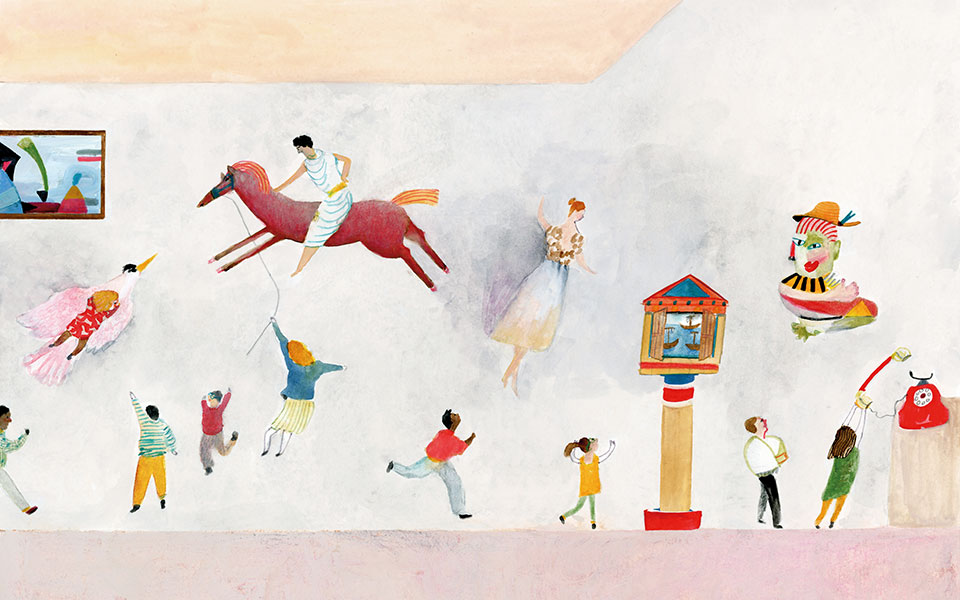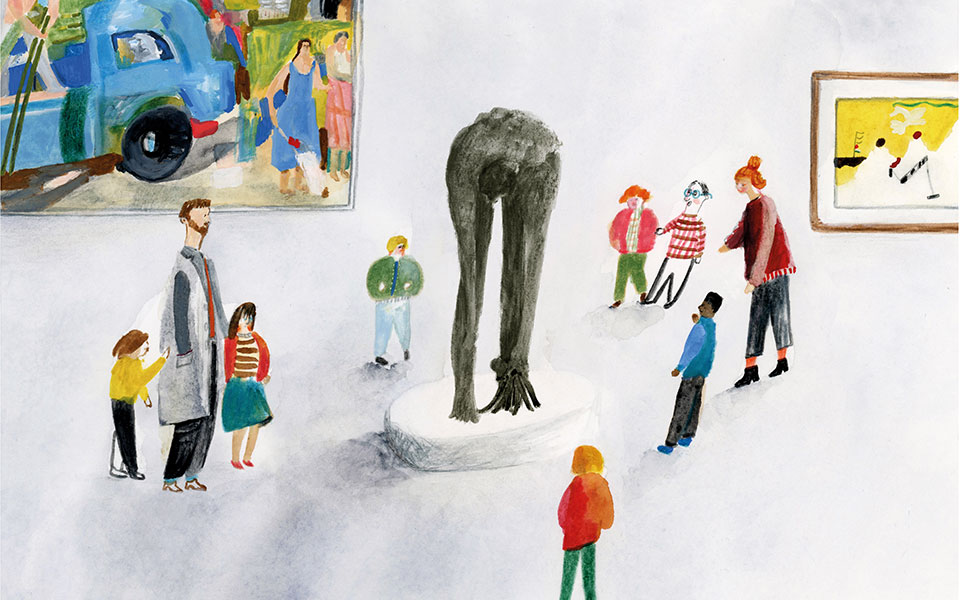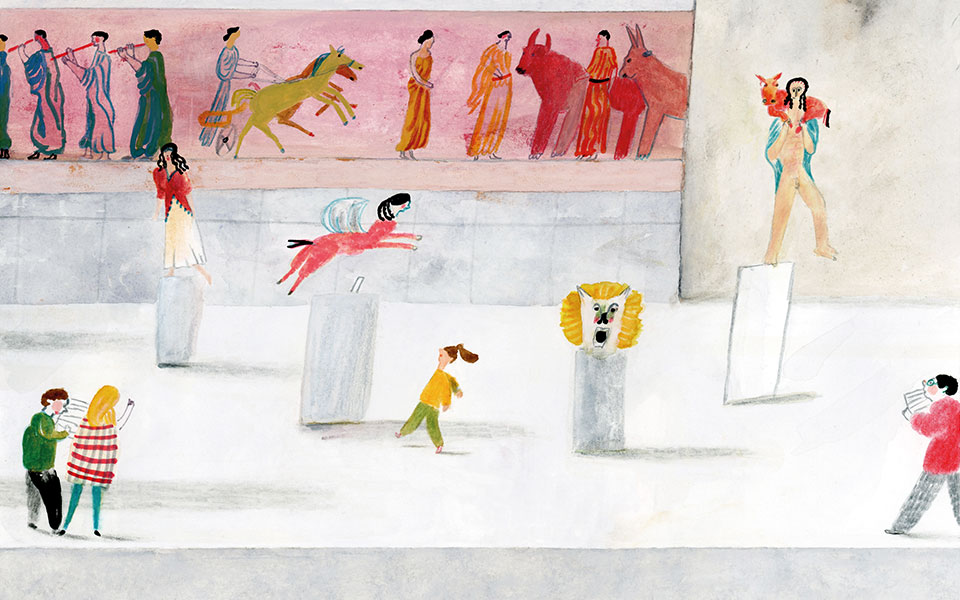The world’s earliest analog computer, the first robot in history, and the gods of Olympus; masterpieces of ancient Greek, Roman, Byzantine and contemporary art; plants and animals that live on the surface of the earth, in the vastness of the sky and in the depths of the ocean; and illusions that fool the mind and the eye: the museums of Athens can conjure up a magical world for young visitors, sparking their imagination. Tailored programs and tours take them on a journey of experiential learning through play.
happy trails
At the Acropolis Museum, children can follow different paths of exploration. Specially designed pamphlets for younger visitors highlight subject matter and difficulty levels suitable for different age groups. With these in hand, young explorers can discover the museum’s treasures while exercising their memory, using their imagination, and having fun. One trail, “The Parthenon Sculptures: Six Short Stories of Separation,” takes them to the Parthenon Gallery on the museum’s third floor, where they’ll find out more about what are arguably the most famous sculptures in the world. Through the stories of these masterpieces, they’ll learn how and why some became separated and where they are today.
On the trail “Spot the Animals,” the goddess Iris will help children three to five years old find some of the animal sculptures in the museum’s collection, including: snakes; a lion; a small calf being carried as an offering to the goddess Athena; a bear, one of the favorite animals of the goddess Artemis; and an owl, the symbol of wisdom. Number games and quizzes, as well as a mission to help Iris find the Olympian gods, will hold the interest of older children. By the time they leave the museum, these young explorers will have learned some fascinating facts about antiquity.
Info
Acropolis Museum, 15 Dionysiou Areopagitou
Open daily 09:00-17:00, admission: €5
For more info, go to theacropolismuseum.gr
The origins of technology
Can a robot operate without batteries or electricity? Ancient musical instruments and toys, the ancient Greek “smart” home, an innovative wine jug, and an automaton puppet theater are some of the unique interactive exhibits at the Kotsanas Museum of Ancient Greek Technology. From the robotic “servant” of Philo of Byzantium to the mechanized puppet theater of Hero of Alexandria, and from the mechanical clock of Ctesibius to the world’s first analog computer, the Antikythera Mechanism, the technologies on display cover the period from 2000 BC to the end of the Ancient Greek era. The Kotsanas Museum features fully functional replicas of more than 400 inventions, many of which remain relatively unknown. Young visitors will be struck by the similarities between ancient innovations and the origins of modern technology. Ctesibius, Plato, Aristotle and other great minds are willing to share their secrets. Are you ready to join them?
Info
Kotsanas Museum of Ancient Greek Technology, 6 Pindarou
open Tue-Sun 9:00-15:00, admission: €12

© Illustrations: Christos Kourtoglou
Just an illusion
At the Museum of Illusions, nothing is what it seems. Here, anything can happen, and every visit is an exciting adventure that will leave children and parents alike wide-eyed in disbelief. You’ll watch yourself shrink, see double, experience holograms, and even… disappear! Through a series of illusions, visitors will learn that their senses can be fooled and that the world is full of visual percepts that appear to be at odds with reality. A stop here is sure to entertain museumgoers of all ages.
Info
Museum of Illusions, 119 Ermou
open Mon-Fri 10:00-21:00 Sat & Sun 10:00-22:00, admission: €10
For more info, go to museumofillusions.gr
art for all
How does a child interpret a painting or understand a movement in art? With the help of valuable insights from a tour guide at the Art Collection of the Basil & Elise Goulandris Foundation, children can discover the fascinating stories behind this collection’s unique artworks. Accompanied by the guide, the entire family can visit the museum’s four floors and discuss the paintings and sculptures on display. Children will be encouraged to imitate the movement of Degas’ “Little Dancer,” and imagine just what a Kandinsky painting depicts.
They’ll talk about abstraction, or draw a chair as they see it, just as Cézanne did. They can participate in group and individual activities and games with a surrealist slant, adopting the slow-looking approach, based on the idea that to understand a work of art, one must spend time with it. At weekends, there are workshops where children draw inspiration from one of the artworks to create their own, using techniques other than painting, such as screen printing or loom weaving. With a strong focus on participation, personal experience, and free expression, the museum’s family tours have been designed specifically to create a shared experience based on the interaction of family members and their responses to the artworks on exhibit.
Info
Basil & Elise Goulandris Foundation, 13 Eratosthenous.
The guided tours are by appointment only, for groups of up to 10 visitors (children and parents), and last 75 minutes.
For more info, call Tel. (+30) 210.010.2156 or send an email to [email protected], goulandris.gr

© Illustrations: Christos Kourtoglou
Herons, butterflies & koalas
As they explore the fantastic collection of the Goulandris Natural History Museum, visitors learn about the reptiles of the world, from the Caretta caretta sea turtle to the Nile crocodile (there is even an accurate replica of a Triceratops), as well as 180 species of birds that nest in Greece, along with birds from Africa and Central America. In the museum’s entomological exhibition, they can admire butterflies and other species of insects from various countries, while the mammal collection includes the kangaroo, koala, lions, leopards, baboons, and giraffes. The botanical exhibition provides the perfect introduction to the plant kingdom. The museum also has halls dedicated to marine biology, featuring an impressive collection of shells from the Greek seas; paleontology, with characteristic samples of fossils; and geology, with an extensive collection of rocks and minerals. All exhibit descriptions are in Greek and English.
Info
Goulandris Natural History Museum, 100 Othonos, Kifissia
Open Mon-Fri 09:00-14:30, Sat & Sun 10:00-15:00, admission: €10
For more info, go to gnhm.gr
Playing with Morse
When was the term “telecommunications” first used? How did signal fires (“fryktories”) work, and when did the ancient Greeks use them to communicate? The OTE Group Telecommunications Museum answers these and many other questions and offers guided tours of its permanent collection in English (subject to booking) so that young visitors and their parents can become acquainted with pre-electric technologies as well as the hydraulic and the optical telegraph, the great inventors of the electric telegraph and telephony, and the development of communications in Greece.
Info
OTE Group Telecommunications Museum, 25 Proteos, Nea Kifissia
Open Mon-Fri 10:00-17:00, every other Sun 10:00-17:00, admission free.
For more info, go to otegroupmuseum.gr
I cook, I play, I learn
The Hellenic Children’s Museum focuses on offering an interactive and participatory experience, encouraging children as young as eight months old to play with, touch, and use different toys and other objects. Depending on their age, children can explore the various rooms and have fun with everything from sensory toys, water, soap and bubbles for the little ones to role-playing games, music, and painting for their older counterparts.
In “The Kitchen,” they learn to cook together (with the help of onscreen instructions) and to experiment with their own recipes, as they get a taste of cooperation and teamwork before finally tasting the results of their efforts. “The ABC of Nutrition” is a small-scale version of a supermarket, complete with a bakery section, a fruit and vegetable aisle, a butcher’s counter and a seafood stall; children can play different roles (e.g., storekeeper, customer, employee) while learning all about healthy eating habits, a balanced diet, and consumer awareness. They can also visit “The Attic” to find out more about objects from the museum’s collection and learn about daily life in the mid-20th century.
Info
Hellenic Children’s Museum, 19 Vasileos Georgiou II
Open Fri 17:00-20:00, Sat & Sun 11:00-15:00, admission free, but visits must be booked in advance at [email protected].
For more info, go to hcm.gr












